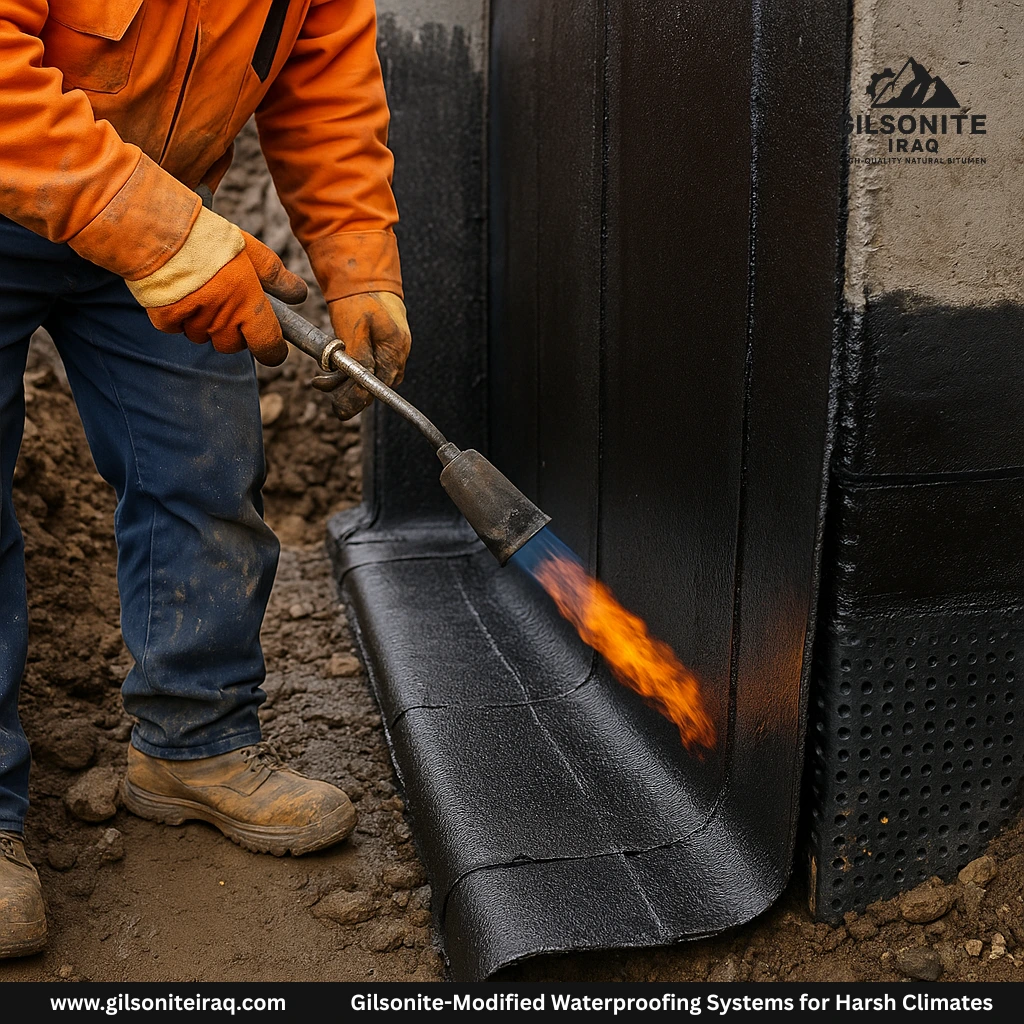Why Gilsonite Matters in Extreme Weather
Gilsonite (natural bitumen) brings high fixed-carbon content, intrinsic hydrophobicity, strong film-forming behavior, and excellent compatibility with bituminous binders. In harsh climates—desert heat and UV, freeze–thaw cycles, monsoon rains, and saline coasts—gilsonite waterproofing systems can extend service life, reduce maintenance, and lower whole-life costs.
System Types: Where Gilsonite Fits Best
- Hot-applied gilsonite membranes (cast or mop systems): Seamless, self-healing behavior; ideal for podium decks, tunnels, foundations, and tanks.
- Cold-applied gilsonite coatings (solvent or waterborne emulsions): Brush/roller/spray application for roofs, parapets, wet rooms, and wall backfill.
- Gilsonite-modified sheet systems (APP/SBS rolls): Torch-on or self-adhered sheets enhanced with gilsonite for stiffness, tack, and durability.
- Detailing mastics & joint sealers: Gilsonite paste for penetrations, terminations, and cracks, improving self-sealing under movement. (National Roofing Contractors Association)
Climate-Specific Design Guidance
Desert & High-UV Regions (solar farms, Middle East/North Africa)
- Binder choice: Use high softening-point gilsonite grades in the blend to resist heat flow.
- Top protection: Add UV-resistant mineral granules or a reflective topcoat (cool roof) to limit thermal aging.
- Movement handling: Include reinforcement (polyester/fiberglass) in high-movement areas to control cracking.
Freeze–Thaw & Cold Regions (high altitude, continental climates)
- Flexibility: Combine gilsonite with SBS or elastomeric polymers (Transportation Research Board)to achieve low-temperature flexibility and crack-bridging.
- Drainage design: Positive slope and well-detailed outlets reduce ice lens formation and standing water.
- Adhesion primers: Cold-tolerant primers ensure wet-out on cool substrates.
Coastal & Saline Environments (ports, desalination plants)
- Chemical splash & chloride exposure: Favor dense, well-crosslinked gilsonite layers; top with anti-corrosion coatings for embedded steel.
- Vapor pressure: For below-grade walls, choose vapor-resistant gilsonite layers with protected drainage boards.
- Fasteners & terminations: Use stainless or coated metals; seal edges with gilsonite mastic.
Monsoon/High-Rainfall Regions (tropical)
- Hydrostatic head: Select multi-layer gilsonite systems with reinforcement scrims (American Concrete Institute); verify permeability and seam integrity.
- Cure windows: Cold-applied emulsions need dry weather; plan staging and temporary protection.
Specs That Drive Performance (and Price)
- Softening point (Ring & Ball): Choose a target with ± band (e.g., ±3–5 °C) that matches service temperatures.
- Ash content (%): Lower ash = cleaner binder and better aging; set a max.
- Particle size / mesh (for powders & mastics): Finer grades (<200 mesh) improve dispersion and film smoothness.
- Moisture & volatiles: Control for safer heating and predictable viscosity.
- Solubility profile: Confirms compatibility and purity for coatings and emulsions.
Formulation Playbook (Typical Ranges—tune by lab trials)
- Hot-applied membranes: Base bitumen + 5–20% gilsonite by binder weight; add elastomer (SBS) if low-temp flexibility is required.
- Cold-applied coatings (solvent): Cutback/asphaltic resin + 5–15% gilsonite for film strength and water resistance.
- Emulsions (cationic/anionics): Stable emulsions with 3–10% gilsonite equivalent (solids basis) for tack coats and priming layers.
- Sheet systems (APP/SBS): Incorporate gilsonite into the blend to improve stiffness, adhesion, and mineral filler wetting.
Always validate with drawdowns and pilot patches before full-scale works.
Substrate Prep & Application (Field-Proven Steps)
- Surface condition: Clean, dry, sound substrate; remove laitance/oils; fill bug holes; moisture < spec limit.
- Priming: Use compatible primer (solvent or waterborne) for concrete/metal; verify cure time.
- Detailing first: Corners, terminations, pipe penetrations, and joints—reinforce with scrim and gilsonite mastic.
- Main application:
- Hot-applied: Controlled kettle temps; apply in lifts to target 2–4 mm dry film thickness (project-specific).
- Cold-applied: Wet-film thickness gauge to ensure coverage; avoid pinholes/holiday defects.
- Sheets: Torch/self-adhere with specified laps; roll to expel air; seal edges with mastic.
- Protection & overburden: Protection boards, geotextiles, or screeds before backfill/traffic.
- Testing: Flood tests (where allowed), adhesion pulls, and holiday detection for continuity.
QA/QC From Mine to Mixer
- On receipt: COA per lot (softening point, ash, moisture, PSD), tamper-evident seals, batch labels.
- On site: Record ambient/substrate temperature, humidity, and dew point; verify primer and coat cure; keep retain samples.
- Documentation: Batch tickets, kettle logs, wet/dry film readings, photos of detailing, and test results.
Safety & EHS Essentials
- Hot works: Follow permits; splash and burn protection; keep kettles vented and monitored.
- Solvent control: Ventilation, respirators where required, and spark-safe equipment.
- Dust control: For powders, minimize airborne dust; use enclosed transfers and PPE.
Maintenance & Life-Cycle
Plan annual inspections (after the first rainy/thermal season): check terminations, penetrations, UV topcoats, and drainage. Gilsonite systems are repair-friendly—local reheating or over-coating often restores continuity at low cost.
Example Configurations (Quick Starters)
- Desert roof over concrete deck: Primer → 2× hot-applied gilsonite lifts with polyester scrim → reflective topcoat or mineral slate.
- Coastal below-grade wall: Primer → gilsonite cold-applied membrane (multi-coat) → drainage board → protection course → backfill.
- Freeze–thaw podium deck: SBS-modified sheet with gilsonite enhancement → torch-on laps → protection screed → pavers.
Procurement & Submittals Checklist
- Grade & spec window tied to climate zone.
- COA/MSDS per lot; packing (PE-lined bags/jumbos; pallets if required).
- Application method statements, primers, reinforcement data sheets.
- Warranty terms linked to maintenance and traffic class.
FAQs: Gilsonite Waterproofing Systems
Is gilsonite compatible with SBS/APP polymers?
Yes—gilsonite blends well with bituminous binders and common modifiers; lab trials optimize stiffness vs flexibility.
Can I use gilsonite emulsions in wet weather?
Avoid application during rain or at/below dew point; follow the product’s cure window for reliable film formation.
How do I verify field quality?
Measure wet/dry film thickness, run adhesion tests on coupons, perform flood/holiday tests as specified, and keep retain samples tied to lot IDs.


